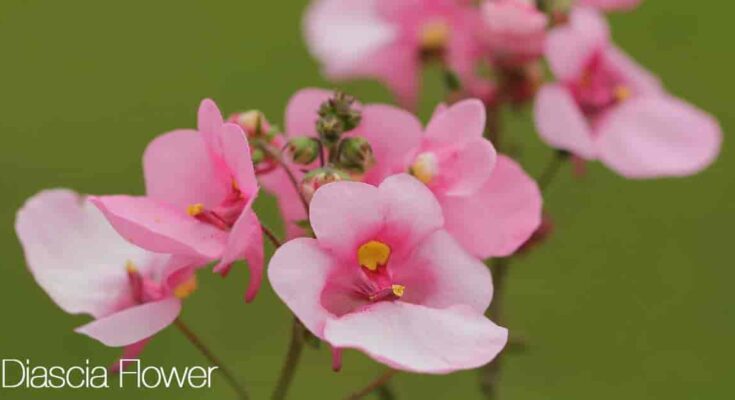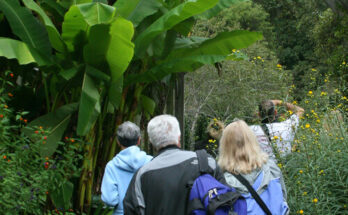If you are interested in learning how to grow and care for the Diascia flower you are at the right place. The Diascia plant is comprised of 70 tender perennial species, annual, and herbaceous flowering plants, belonging to the Scrophulariaceae family.
These are a delicate kind of plant, native to southern Africa, including Lesotho, South Africa, and neighboring areas. Some varieties grow upright, while others spill over pots. Many Diascia plants are hybridized for better blooms and new colors you’ll find at garden centers.
The common names for Diascia [Dy-ASS-ee-uh] include:
- Twinspur
- Barber’s Diascia
Diascia Plant Care
Size & Growth
Many species of this plant grow up to 6” – 12” inches tall and about 18” inches in diameter, which makes them highly useful for ground cover.
Flowering and Fragrance
The twinspur flower is shell-shaped or dainty cup-shaped, typically in orange flowers but also in, peach, white, and pink flower colors.
They are small in size but still profuse. The unique thing about the flowers is the one petal which is longer than the rest, resembling a tongue sticking out.
Moreover, the two side petals below the larger petal have spur-like or horn-like projections.
Light & Temperature
Diascia plants need full sun to bloom fully. During the scorching heat, this plant prefers partial shade, mostly in the afternoon.
To germinate, these plants need sufficient light and moist soil.
It will tolerate light frost, but will not be able to endure the harsh heat of the summer. Hardiness USDA Zones 5 – 9.
Watering and Feeding
When grown in borders and beds, the plants must be watered when the top inch of the soil starts drying out.
It is best to spread a mulch layer on the ground to keep the roots moist and cool, as this will help the plants stay healthy for a prolonged time.
Feed the plant with timed-release fertilizer or general-purpose fertilizer when planting.
Soil & Transplanting
Diascia prefers a fertile, light, and well-drained soil.
It easily grows in loam, sand, or chalk and the pH level of the soil should preferably be slightly acidic, between 6.0 and 6.5.
Make sure the soil being used has high levels of magnesium and calcium, with reduced ammonium nitrogen levels.
It is best to amend sandy soil or heavy clay with compost or any organic matter before planting.
Grooming and Maintenance
Regularly remove any wilting flowers to increase flower-bearing.
During harsh temperatures, water the plants in the evenings to prevent the plant from drying out.
Cut the plant back after winter to enhance growth.
Diascia flowers love cool temperatures, making the plant perfect during the fall and spring seasons.
If there are signs of fading, especially in the heat, trim them a few inches, and increase the amount of water.
The plant will become healthy again as it starts cooling off.
Older plants start becoming straggly, which is why it is best to replant Diascia after a few years.
How To Propagate Twinspur
Diascia propagation of this plant is done through seeds.
- It is best to sow the seeds during the early spring season, in mild heat.
- Seeds can be sown directly in the garden.
- However, it is best to prep the seeds indoors at least 8 to 10 weeks before the last frost.
- The prepped seeds should be planted outdoors once the soil has started warming up and the temperature reaches 60° degrees Fahrenheit (15° C).
- The ideal temperatures maintained should be between 60° – 65° degrees Fahrenheit (15° – 18° C) until the germination process starts.
- The germination of this plant requires sufficient light.
- Therefore, it is best to firmly press the seeds at the surface of the soil, instead of covering it.
- Ensure the soil stays moist for the roots to establish.
- The germination process typically takes around two weeks.
The plant may also be propagated using semi-hardwood cuttings.
The cuttings must be taken during mid-summer or spring.
Barber’s Diascia Pest or Diseases
Diseases are not a significant issue for Diascia plants unless they experience a highly wet season.
The major pest issue for these plants is slugs and snails.
It is best to lift the plants from the ground to avoid the pests or use a mild spray to eliminate them.
Twinspur Uses
The ideal use of Diascia species is:
- In containers like hanging baskets or window boxes.
- The entire container may either be filled with one variety or with different types.
- Diascias are often used as a spiller in a mixed container.
- The plants look stunning as edging plants as they elegantly spill over walls and sidewalks.
- The sprawling plant adds color and beauty in rock gardens, borders, and beds.
Once you learn how to grow and care for the Diascia flower, you will be planting them in summer bedding schemes, in the forefront of a bordered carpet, rockery specimen, and as edging plants.
Source link
Originally posted 2022-09-30 17:52:28.





